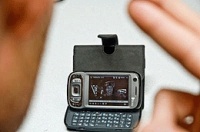Mobile device transmits sign langauge
University of Washington (UW) engineers are developing what is claimed to be the first device to transmit American Sign Language (ASL) over mobile phone networks in the US.

The tool is currently completing its initial field test by participants in a UW summer programme for deaf and hard-of-hearing students.
‘This is the first study of how deaf people in the United States use mobile video phones,’ said project leader Eve Riskin, a UW professor of electrical engineering.

The MobileASL team has been working to optimise compressed video signals for sign language.
By increasing image quality around the face and hands, researchers have brought the data rate down to 30 kilobytes per second while still delivering intelligible sign language.
MobileASL also uses motion detection to identify whether a person is signing or not, in order to extend the phone’s battery life during video use.
Bandwidth issues
Phones including the iPhone 4 and the HTC Evo offer video conferencing but users are said to have encountered problems due to broadband companies blocking high-bandwidth video conferencing from their networks. Similarly, companies are rolling out tiered pricing plans that would charge more to heavy data users.
Register now to continue reading
Thanks for visiting The Engineer. You’ve now reached your monthly limit of news stories. Register for free to unlock unlimited access to all of our news coverage, as well as premium content including opinion, in-depth features and special reports.
Benefits of registering
-
In-depth insights and coverage of key emerging trends
-
Unrestricted access to special reports throughout the year
-
Daily technology news delivered straight to your inbox










Water Sector Talent Exodus Could Cripple The Sector
Maybe if things are essential for the running of a country and we want to pay a fair price we should be running these utilities on a not for profit...